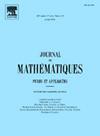正态流的神经传递控制
IF 2.1
1区 数学
Q1 MATHEMATICS
引用次数: 2
摘要
受归一化流的启发,我们利用时间相关的速度场来分析神经传递方程的双线性控制,这些速度场被限制在任何时间实例上,以满足一个简单的神经网络分析。证明了L1近似可控性,表明任意概率密度都可以在任意时间范围内被驱动到任意另一个概率密度附近。控制向量场是显式地和归纳地建立的,这提供了对它们的复杂性和幅度的定量估计。当只有目标概率密度的随机样本可用时,这也会导致统计误差界限。inspirs samsams par flux normalisaturs, nous分析为contrôle bilinsamaire des samsamas de transport neuron或moyen de champs de vitesse dsampendant du temps and limites samsamas vsamrifier, chaque instance temporelle,简单分析为samsamseau neuron。仲裁解决办法:本文章由计算机程序翻译,如有差异,请以英文原文为准。
Control of neural transport for normalising flows
Inspired by normalising flows, we analyse the bilinear control of neural transport equations by means of time-dependent velocity fields restricted to fulfil, at any time instance, a simple neural network ansatz. The approximate controllability property is proved, showing that any probability density can be driven arbitrarily close to any other one in any time horizon. The control vector fields are built explicitly and inductively and this provides quantitative estimates on their complexity and amplitude. This also leads to statistical error bounds when only random samples of the target probability density are available.
求助全文
通过发布文献求助,成功后即可免费获取论文全文。
去求助
来源期刊
CiteScore
4.30
自引率
0.00%
发文量
84
审稿时长
6 months
期刊介绍:
Published from 1836 by the leading French mathematicians, the Journal des Mathématiques Pures et Appliquées is the second oldest international mathematical journal in the world. It was founded by Joseph Liouville and published continuously by leading French Mathematicians - among the latest: Jean Leray, Jacques-Louis Lions, Paul Malliavin and presently Pierre-Louis Lions.

 求助内容:
求助内容: 应助结果提醒方式:
应助结果提醒方式:


